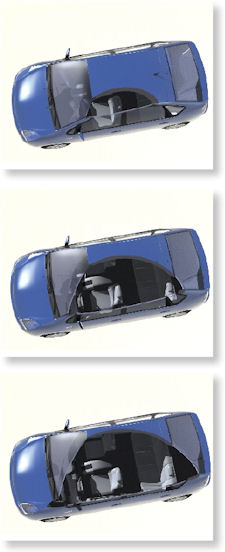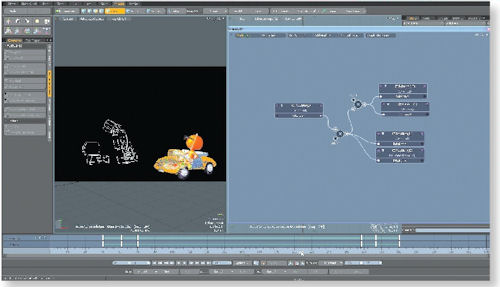Latest News
July 2, 2012
By Mark Clarkson
Luxology modo 601, the latest version of Luxology’s polygon and subdivision surface modeler and renderer, is still relatively cheap—but the price is up from $995 to $1,195.
What do you get for that extra $200? A lot, actually, but all of the upgrades might not be useful for your work.
 |
| Using the new camera clipping plane, as the camera approaches the object, it is progressively clipped away. |
Character Animation
Let’s get this one out of the way up front: Version 601 is modo’s “character animation” release. If you do animated characters, this is the release of modo you’ve been waiting for, incorporating full 3D inverse kinematics (IK) and bones.
Think of a human figure. With forward kinematics, you rotate the shoulder, the elbow and the wrist to put the hand where you want it. With IK, you move the hand and the application calculates the rotation of the wrist, elbow and shoulder for you. IK is great for many animations, from robot arms to folding mechanisms.
Bones are just what they sound like. Put them inside of a “soft” body, and they control and distort the mesh. A human figure would have bones mimicking the human skeleton. Rotate them, and a joint bends. Primarily thought of as a character animation tool—which they are—bones are useful in animating other soft bodies, from hoses to curtains to what-have-you.
Dynamics & Volumes
modo 601 includes integrated dynamics simulation with recoil. Based on the Bullet Dynamics Engine, simulates both soft and rigid bodies. Soft bodies are good for capes, drapes and ropes.
As for rigid bodies, “drop” a handful of screws over a tabletop, and they will fall, collide, bounce and roll realistically. It’s actually a neat way to create heaps and scatterings of objects without fussing about with individually placing dozens or hundreds of objects.
For more complex simulations, you can add triggers, forces and constraints, and springs and motors. modo now offers volumes, allowing you to create everything from infinite ground planes to ground fog to puffy clouds, to whole forests populated with 2D billboards of camera-facing trees. There are also viscous new “blobs” that can merge and separate—good for modeling, say, fluids pouring from a bottle.
Rounded Edge Rendering
So you don’t do character animation or special effects. You don’t need clouds or foggy rooms, and you’re not interested in dynamics simulations. What’s modo 601 got for you?
Let’s start with rounded edge rendering. Imported meshes, especially low-resolution meshes, can look fake when rendered—owing mainly to their geometrically perfect edges. The same is true, of course, of meshes you create in modo.
But Luxology has added “rounded edges” to 601’s material options, providing beveled edges at render time without the effort and geometric overhead of actually beveling the edges. Rounding is definable by material, so you can give Chrome_1 a 1.2mm bevel, Chrome_2 a 2.0mm bevel, and Red_Plastic no bevel at all.
You will take a hit at render time, however. Renders took between 20% and 50% longer in my tests.
CAD Loaders
modo will import many standard file formats, including DXF, COLLADA and SolidWorks parts and assemblies, but control over the process is limited. If you work with a lot of imported CAD files, you’ll probably want to consider Luxology’s CAD loaders. They produce nice, smooth-shaded quad polygons, instead of the usual mess of triangles, and give you more control over the tessellation process.
The basic CAD loader ($495) imports Parasolid. The advanced CAD loader ($695) will also read IGES and STEP files. A little pricey, perhaps, given modo’s $1,199 price tag, but they can pay for themselves quickly if you spend much time working with imported meshes.
 |
| An imported SolidWorks assembly rendered without rounded edges (left) and with rounded edges (right). |
Re-topology
Imported objects are often too dense for your needs. Even a simple box or cylinder can come in from CAD with hundreds of triangles. The “flow” of the mesh can also be off, with clusters of triangles creating undesirable bumps. modo 601 has a new workspace and dedicated set of tools for creating a new, low-resolution mesh from a high-resolution mesh.
To create your new model, place your high-density mesh in the background. Every time you lay down a point in the foreground, it snaps to the surface of the background mesh and adopts that surface’s normal (which way is “up,” for example). Drag out rows of polygons at once, and they all stick to the background mesh. The background mesh constraint was available in modo 501, but it had to be set for every tool you used. It is now built into the topology workflow.
I’d say that about 90% of your work can be done with the new Topology Pen, which allows you to drag out polygons to create a new mesh with truly astonishing speed and ease. If you do re-topology work, the new topology workflow alone is probably worth the upgrade price.
Custom Tools
One of modo’s key features is the way it allows you to get into its “tool pipeline,” combining different operations to create your own tools. Combine the Rotate tool with a linear falloff, and you’ve got a Bend tool. Combine them a different way, and you’ve got a Twist tool.
modo already has these tools, of course, but if you look under the hood, you’ll see that this is exactly how they’re built. You can then create your own tools that better suit your purposes and add them to the tool palette.
Camera Clipping & Render Booleans
modo 601 offers two new ways to produce easy cut-away views of your models: camera clipping planes and render Booleans.
With a camera clipping plane, as you move the camera through the scene, or leave the camera still and move the clipping plane, your objects are clipped away as the plane intersects them, revealing what’s inside: the gears in your transmission or the electronic components inside your mouse. You can make objects immune to clipping on a per-material basis.
Render Booleans work similarly, except that they are animatable 3D objects—cylinders, cubes or spheres.
 |
| modo’s schematic view allows you to set up relationships between items. Here, one object drives the rotation of all the car’s wheels. |
Rendering
Modo’s renderer produces terrific, photo-real images and animations. The addition of a cel shader and cel edges material lets you create non-photoreal images now as well. You can choose from an assortment of standard camera backs and create custom lenses, complete with lens distortion and iris blade effects.
 |
| The new recoil dynamics simulation. Three rigid balls and a soft donut fall into the scene from above. |
601’s renderer provides you with a comprehensive set of statistics on each render—from elapsed time to frame buffer memory to the number of refraction rays generated. You also get a good set of image post-processing controls for making adjustments to contrast, brightness, color cast, saturation and light bloom.
modo’s renderer made big speed improvements with the last version. Unfortunately, it’s apparently given some of them back with 601. My renders were consistently slower, with 601 taking 20% longer or more. I think it’s time for Luxology to better leverage the power of all those GPUs sitting on my desktop. (Update: Luxology says its recent service pack No. 2 release has fixed these issues. And in fact, in my quick non-comprehensive tests, SP2 renders scenes in 80-90% the time of my review version of the software.)
Render Passes
The new render passes can really speed up your production pipeline. You can set up a scene to render out separate passes for each frame. Traditionally, in visual effects, you use this feature to render an object’s color, reflections, shadows, etc., separately, so you can tweak them in post-processing. But with modo’s implementation, you can set up separate render passes for almost anything.
Yes, you can render colors and reflections separately, but you can also render passes with completely different colors and different reflections. You can have a model with four different materials—say, red, blue, green and gloss black. Set up a different render pass for each material—and every render, or every frame of your animation, automatically produces four different images. You can have render passes for different lights, or different backgrounds. Any channel that can be changed can be included in a render pass.
Summing It up
I have skimmed the surface of new features, which also include new skin and hair shaders, particle generators and particle sculpting tools, tons of new deformers for both modeling and animation, a much-improved preview renderer, and a most welcome mesh cleanup tool. You can now paint interactively on any layer—bump maps, specularity maps, etc.
It’s not a perfect upgrade. Some of the help isn’t up to date, and I experienced my fair share of crashes and user-interface weirdness. But I find this to be an exciting upgrade, and am impressed by the new features modo brings with every new version. You can give modo 601 a try for free at Luxology.com/trymodo.
Contributing Editor Mark Clarkson is DE’s expert in visualization, computer animation, and graphics. His newest book is Photoshop Elements by Example. Visit him on the web at MarkClarkson.com or send e-mail about this article to [email protected].
More Info
Subscribe to our FREE magazine, FREE email newsletters or both!
Latest News
About the Author
Mark ClarksonContributing Editor Mark Clarkson is Digital Engineering’s expert in visualization, computer animation, and graphics. His newest book is Photoshop Elements by Example. Visit him on the web at MarkClarkson.com or send e-mail about this article to [email protected].
Follow DE





